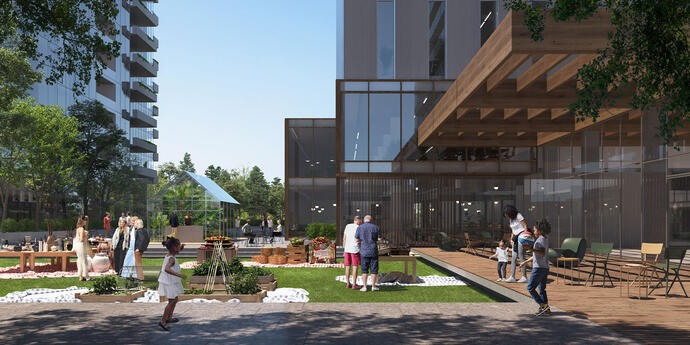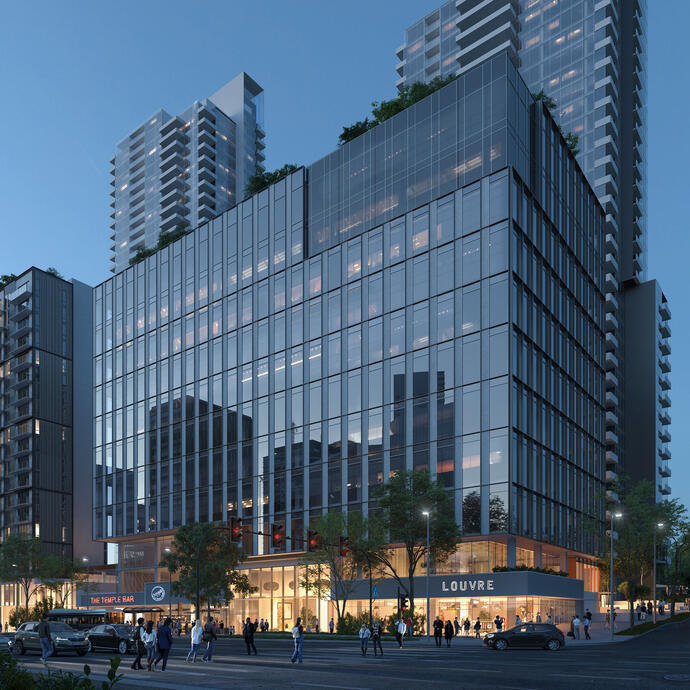Renderings courtesy of ZGF Architects
Smith + Andersen's Intelligent Integrated Systems (IIS) team was engaged to design a converged building network and an intelligent building management platform for Century City—a mixed-use, multi-phase development located near King George Sky Train Station and Holland Park in Surrey, British Columbia. Phase one of Century City includes residential rental units and a market hall, with an office tower and condo towers in phases to follow. Learn how this Intelligent Building uses industry-leading technology to maximize the experience for property management and tenants, while simultaneously improving energy efficiency and decreasing operational expenditures.

The Challenge.
Century City’s residential rental tower is the first substantial Intelligent Building in Century Group’s portfolio. It is under certification for WiredScore Home and raises the bar for this client’s developments moving forward. Century Group wanted to prioritize the user experience, while also creating an energy-efficient building with decreased operational expenditures. As the project’s infrastructure and integration designers, Smith + Andersen’s IIS team leveraged industry-leading technology to improve the user experience for property management and future residents and tenants. How? By working with the project team to design with the end-user in mind, right from the beginning of the design process. We’re talking literal, sit-down meetings to walk through typical day-in-the-life user experiences in detail.
The Solution.
Throughout the design process, the S+A IIS team worked closely with Century Group’s operations and management (O&M) team to determine driving factors that would build the foundation of the design. A series of workshops with other design disciplines encouraged collaboration and generated building solutions that worked cohesively to maximize energy efficiency, minimize operational expenditures, and ultimately, improve the user experience.
The client required individual systems that were capable of communicating with other systems over a converged building network that spanned the entire complex – not just within one residential tower, but across future towers in the development as well. Each system on the converged building network supplies information to the intelligent building management platform. This system provides trend and data analysis on everything from security monitoring to management of operations between staff and tenants or residents. By using appropriate network architecture, such as Passive Optical LAN, less infrastructure was necessary to achieve the desired level of connectivity. Less infrastructure means more space for the actual purpose of the building – residential spaces!
The building is intelligent in more ways than one. Through rule-based and machine learning algorithms, the Intelligent Building Management Platform uses pattern recognition to identify potential faults before they occur. The building can perform auto-adjustments through a Building Automation System (BAS) to correct itself and identify opportunities to modify controls. Practically speaking, when pattern variance is detected, maintenance staff are notified to resolve potential issues pre-emptively. Staff can also use the digital signage located throughout the building to broadcast pre-populated messages and keep residents informed. Many of these features actually perform “double-duty” in aligning with Century City’s goals. For example, the digital signage – a key communication tool that achieves their integration objectives – also contributes to lower operational costs.
Understanding the user-experience didn’t just mean thinking about the building residents and staff. The intelligent systems have visitors in mind, too. When a courier arrives at the building to deliver food or parcels, they can scan the barcode of an “in-transit” package and receive access to the corresponding building’s lobby and parcel room. Once the package has been secured in the parcel locker, the resident is sent a phone notification with a temporary credential to access the units in the parcel room. A resident’s mobile device is also the key to purchasing items, receiving notifications on the status of their order, and picking up their items with ease from the grocery bar and market hall. Smith + Andersen’s IIS team worked collaboratively with an app developer to create an application that would increase connectivity throughout the building and make the systems available in the palm of a resident’s hand. All in all, the team examined and accommodated more than 40 use cases!
The Result.
When the residential rental tower at Century City is complete in 2023, the development’s intelligent systems will improve the day-to-day experience of residents, visitors, and property management staff alike. Smith + Andersen designers know that every building is unique and each user within each building will have unique experiences. A good designer puts themselves in the shoes of the people they are designing for, which leads to the creation of systems that meet client goals, while simultaneously improving the overall experience that future residents and staff will have. Rather than using a “one size fits all” mould and fitting technology into a designated space, the IIS team considers all users and allows their experience to shape the technology implemented. When it comes to Intelligent Buildings, designing with the end-user in mind right from the start of the process is the key to truly unlocking a development’s potential.
To learn more about this project, please visit the Project Page.

